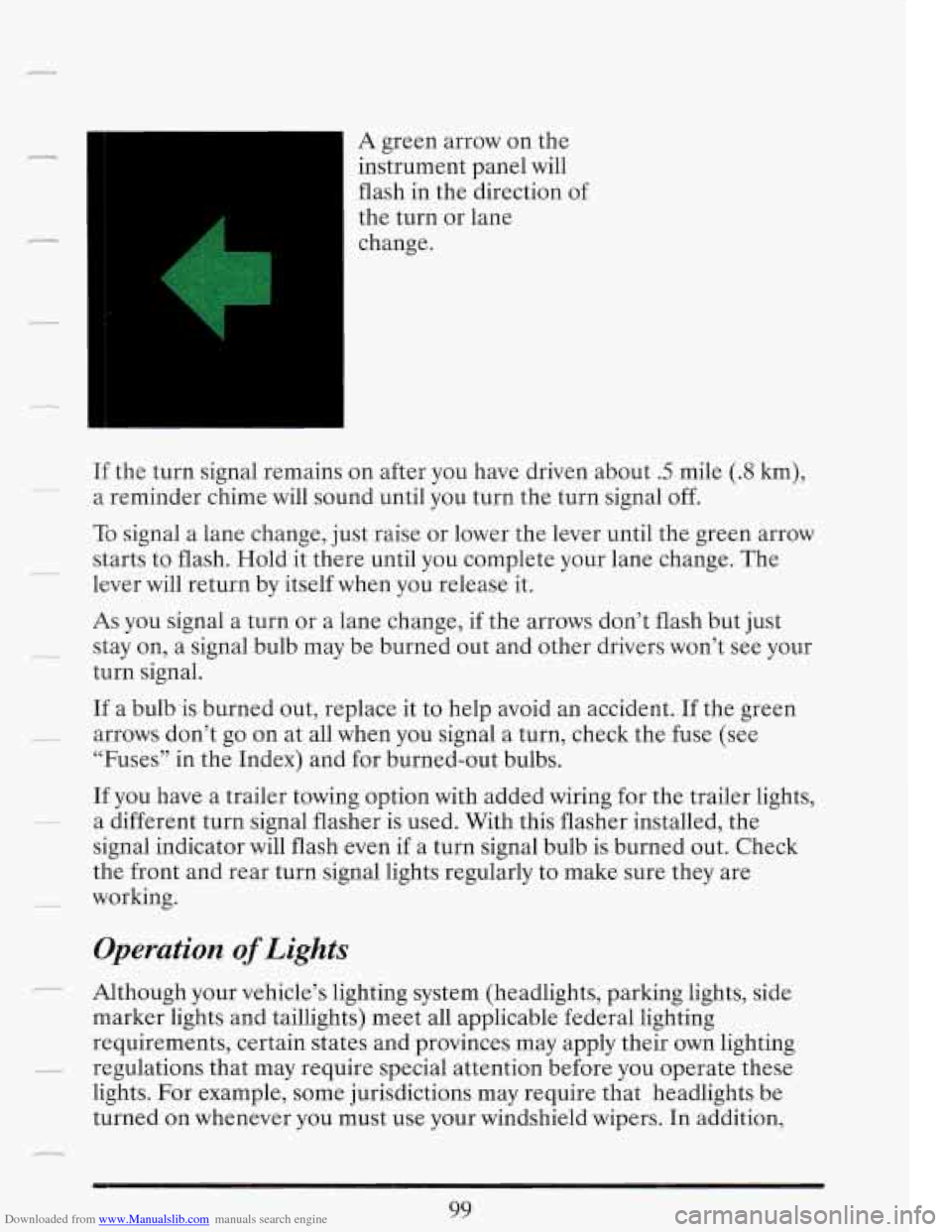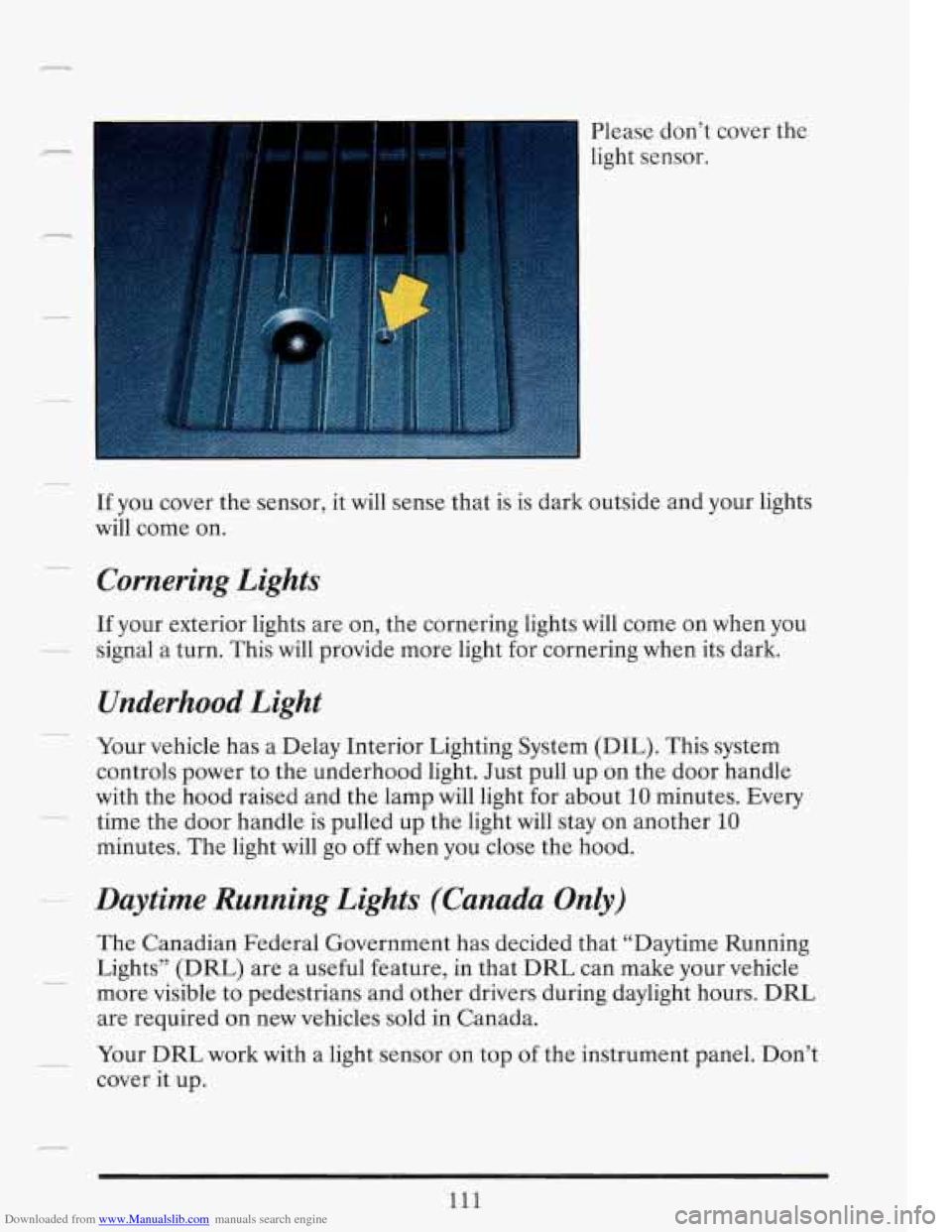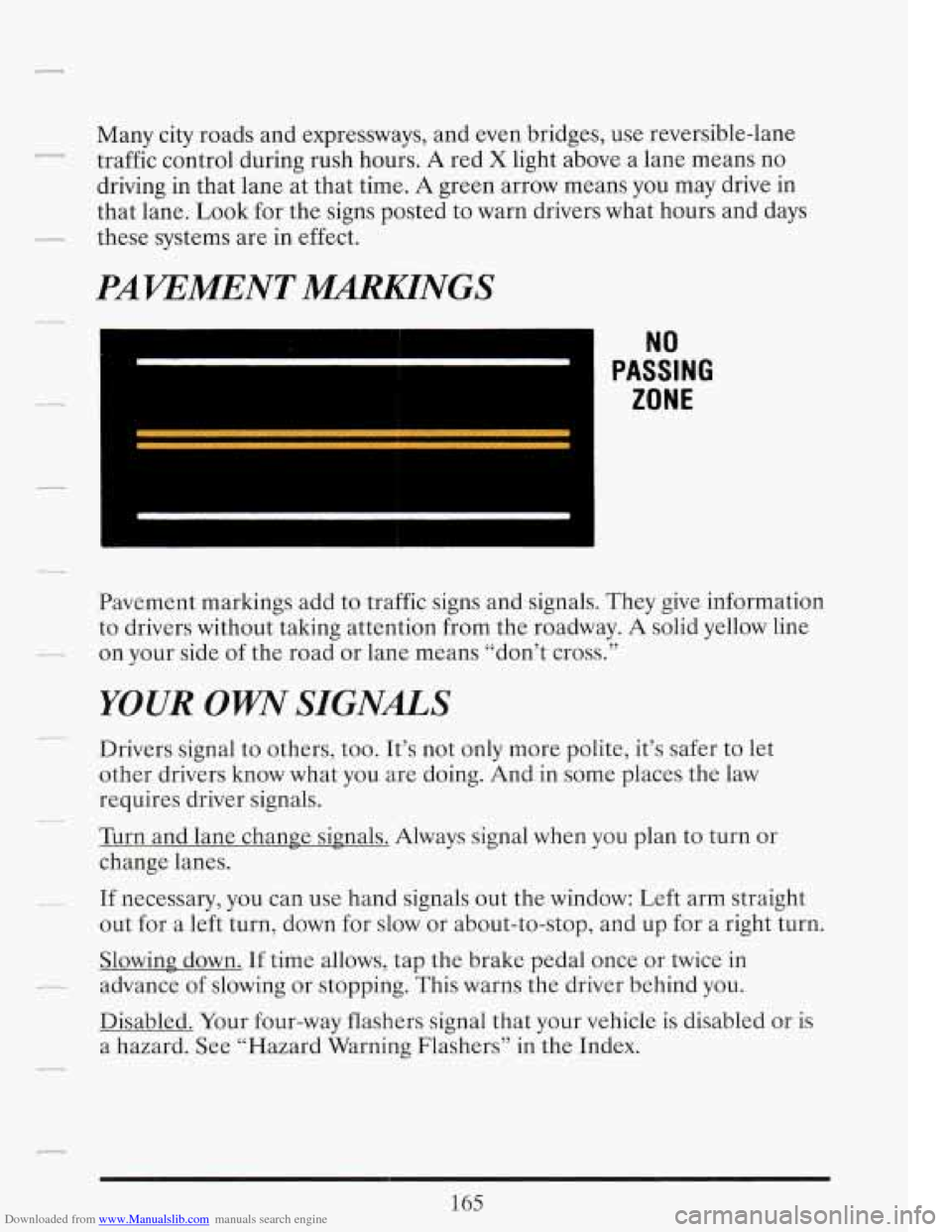Page 18 of 386
Downloaded from www.Manualslib.com manuals search engine These symbols have to do with your lights:
-
'I a-
i
TURN SIGNALS I
MASTER LIGHTING
SWITCH
u
PARKING LIGHTS
A $0
n
r
HAZARD WARNING FLASHER
I FOG LAMPS
These symbols are on some of your controls:
(j
0W#W
I
WINDSHIELD
WASHER
w
n
I I
WINDSHIELD
WIPER &WASHER WINDSHIELD
DEFROSTER
r VENTILATING FAN
REAR
WINDOW
DEFOGGER I
HEADLAMP
WASHER/WIPER
4
Page 112 of 386
Downloaded from www.Manualslib.com manuals search engine The lever on the left side of the steering column includes your:
0 Turn Signal and Lane Change Indicator
0 Headlight High-Low Beam & Passing Signal
0 Windshield Wipers
0 Windshield Washer
0 Cruise Control
Turn Signal and Lane Change Indicator
The turn signal has
two upward (for Right)
and
two downward
(for Left) positions.
These positions allow
you to signal a turn or
a lane change.
To signal a turn, move the lever all the way up or down. When the turn is
finished, the lever will return automatically.
98
n
*-' I
n .
*
-
dl
n
-
e-
Page 113 of 386

Downloaded from www.Manualslib.com manuals search engine A green arrow on the
instrument panel will
flash in the direction of
the turn or lane
change.
If the turn signal remains on after you have driven about .5 mile (.8 km),
a reminder chime will sound until you turn the turn signal off.
To signal a lane change, just raise or lower the lever until the green arrow
starts to flash. Hold it there until you complete your lane change. The
lever will return by itself when you release it.
AS you signal a turn or a lane change, if the arrows don’t flash but just
stay on, a signal bulb may be burned out and other drivers won’t see your
turn signal.
If a bulb is burned out, replace it to help avoid an accident. If the green
arrows don’t go on at all when you signal a turn, check the fuse (see
“Fuses” in the Index) and for burned-out bulbs.
If you have a trailer towing option with added wiring for the trailer lights,
a different turn signal flasher is used. With this flasher installed, the
signal indicator will flash even if a turn signal bulb is burned out. Check
the front and rear turn signal lights regularly to make sure they are
working.
Operation of Lights
Although your vehicle’s lighting system (headlights, parking lights, side
marker lights and taillights) meet all applicable federal lighting
requirements, certain states and provinces may apply their own lighting
regulations that may require special attention before you operate these
lights. For example, some jurisdictions may require that headlights be
turned on whenever you must use your windshield wipers. In addition,
Page 114 of 386
Downloaded from www.Manualslib.com manuals search engine most jurisdictions prohibit driving solely with parking lights, especially at
dawn or dusk. It is recommended that you check with
you own state or
provincial highway authority for applicable lighting regulations.
Headlight High-Low Beam
Windshield Wipers
To change the
headlights from low
beam to high or high to
low, pull the turn signal
lever all the way toward
you. Then release it.
When the high beams
are on, this blue light
on the instrument
panel also will be on.
WIPER To control the wipers, turn the band on the multifunction lever.
MIST: Turn the band to “MIST” and then release it for a single wipe
cycle. For more cycles, hold the band on MIST longer.
1 :I, U
100
Page 125 of 386

Downloaded from www.Manualslib.com manuals search engine .-
Please don’t cover the
light sensor.
If you cover the sensor, it will sense that is is dark outside and your lights
will come on.
__
Cornering Lights
If your exterior lights are on, the cornering lights will come on when you
-- signal a turn. This will provide more light for cornering when its dark.
Underhood Light
~
Your vehicle has a Delay Interior Lighting System (DIL). This system
controls power to the underhood light. Just pull up on the door handle
with the hood raised and the lamp will light for about
10 minutes. Every
minutes. The light will go off when you close the hood.
__ time the door handle is pulled up the light will stay on another 10
Daytime Running Lights (Canada Only)
The Canadian Federal Government has decided that “Daytime Running
Lights” (DRL) are
a useful feature, in that DRL can make your vehicle
more visible to pedestrians and other drivers during daylight hours. DRL
are required on new vehicles sold in Canada. -
__ Your DRL work with a light sensor on top of the instrument panel. Don’t
cover it up.
111
Page 127 of 386
Downloaded from www.Manualslib.com manuals search engine --+. Lamp Monitors
.-
The front lamp
monitors show that
your headlamps, highbeams and turn
signals are working.
The rear lamp
monitors
show that
your taillights are
working.
113
Page 139 of 386

Downloaded from www.Manualslib.com manuals search engine r WmING AND INDICATOR LIGHTS
This section describes the warning lights that are on your vehicle. The
pictures will help you locate them.
Warning lights can signal that something is wrong before it becomes
serious enough to cause an expensive repair or replacement. Paying
attention to your warning lights could also save you or others from injury.
Warning lights go on when there may be or is a problem with one of your
vehicle’s functions.
As you will see in the details on the next few pages,
some warning lights come on briefly when you turn the ignition key just
to
let you know they’re working. If you are familiar with this section, you
should not
be alarmed when this happens.
When one
of the warning lights comes on and stays on when you are
driving, check the section that tells you what to do about it. Please follow
the manual’s advice. Waiting to do repairs can be costly
-- and even
dangerous.
So please get to know your warning lights. They’re a big help.
Brake System Warning Light
Your Cadillac’s hydraulic brake system is divided into two parts. If one
part isn’t working, the other part can still work and stop you. For good
braking, though, you need both parts working well.
If the warning light
goes on, there could be
a brake problem. Have
your brake system
inspected right away.
125
I_ This light should come on as you start the vehicle. If it doesn’t come on
then, have it fixed
so it will be ready to warn you if there’s a problem.
Page 179 of 386

Downloaded from www.Manualslib.com manuals search engine Many city roads and expressways, and even bridges, use reversible-lane
traffic control during rush hours.
A red X light above a lane means no
driving in that lane at that time.
A green arrow means you may drive in
that lane.
Look for the signs posted to warn drivers what hours and days
these systems are in effect.
Pavement markings add
to traffic signs and signals. They give information
to drivers without taking attention from the roadway.
A solid yellow line
on your side of the road or lane means “don’t cross.’’
YOUR OWW SIGNALS
Drivers signal to others, too. It’s not only more polite, it’s safer to let
other drivers know what you are doing. And in some places the law
requires driver signals.
Turn and lane change signals. Always signal when you plan to turn or
change lanes.
If necessary, you can use hand signals out the window: Left arm straight
out for a left turn, down for slow or about-to-stop, and up for a right turn.
Slowing down. If time allows, tap the brake pedal once or twice in
advance of slowing or stopping. This warns the driver behind
you.
Disabled. Your four-way flashers signal that your vehicle is disabled or is
a hazard. See “Hazard Warning Flashers” in the Index.
165